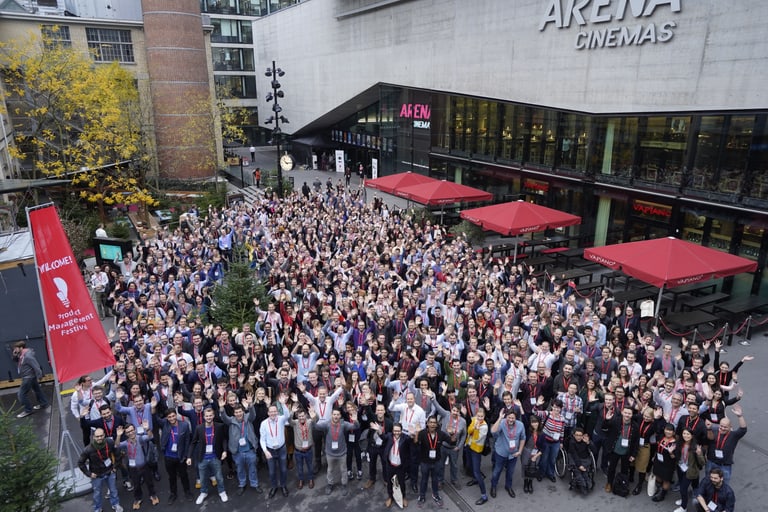In case you missed it, you can find my key takeaways from the first day in this article.
Pricing as a product feature
By Kapeesh Saraf, Senior Director of Product at Coursera
We don't often rework our pricing at Liip, except for our two products Rokka and Houston SaaS.
This talk caught my interest to see how Coursera handles it.
Kapeesh first shared an interesting "Demand vs. price" graph. He said it's your goal as a PM to know where your product price is located on this graph in order to understand your users' willingness to pay.
Obviously, demand fluctuates with price: the cheaper the more people you'll have, and the higher the less persons will signup.
In order to get your price right, there is no magic:
- Understand your persona via A/B testing. For instance, at Zynga, Kapeesh noticed that not many people would buy his virtual toaster (what world we live in...). But the one who'd buy wouldn't care about the pricing. So he was better raising the price! He said he learnt this in hindsight, by doing A/B tests and post-analysis.
- At Coursera, which is a more "mature" and established product (degree), his experience with user surveys proved to be the easiest to go with. Although it's always a matter of techiques' combination.
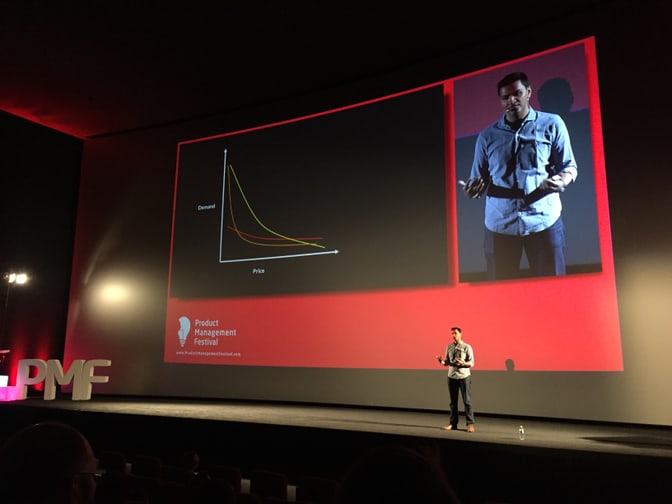
The second key takeway, "Pricing as a feature", is best explained via an example: Coursera used the loss aversion's human psychological trait to increase its retention. They told their students that they'd pay less if they completed their degree faster than standard. It was their way to make sure that people would choose Coursera over Netflix when they got home in the evening. And it worked! After three years using this model, all their metrics increased.
A final reminder that I commonly share with my Liip clients about their product scope: Keep It Stupid Simple (aka KISS). Kapeesh uses it as well for pricing. He shared that the more complex your price is, the more complex your product becomes. And as with scope creep, this makes you lose customers.
How to find the right UX strategy for my product
By Sibylle Peuker, Partner and UX architect at Zeix AG
The thing I learnt from this talk is the definition of a UX strategy. Such concept is a way to align UX and Business. Sibylle summarized it with an equation:
UX strategy = Thorough analysis (of the context) + Shared vision (of the product/project) + UX methods (get the right tools) + Avoid common pitfalls
As Sybille focused on the "Common pitfalls", it left me hungry as I expected the speech to answer my current question: which UX tools and strategy to use for which kind of product, concretely.
I'll have to keep evolving my own decision-tree graph (to be shared in a future article) as I didn't get any answers there.
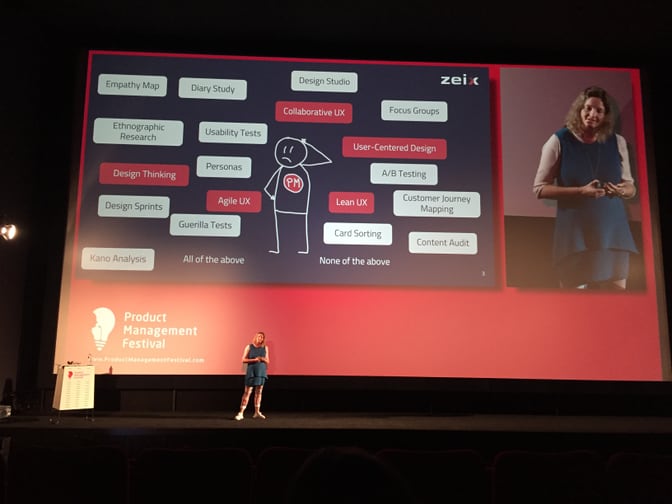
Push Boundaries of Product Growth with Innovation Accounting
By Ilia Kuznetsov and Nick Mitushin from ABRT Venture Fund
I chose this talk to see concrete examples on how innovation accounting is used by a venture-fund company. If you wanna get an intro about the concept, I recommend you to read Eric Ries' "Lean Startup" book.
Nick sees innovation accounting as a way to index the growth of a product. It's pretty simple: make plans for a metric (e.g. how many new customers are expected) to be measured into a spreadsheet for the next two weeks. Do your product improvements. Then, two weeks afterwards, have a reality check. Did your metric increased? If yes, keep improving. If not, adapt your product strategy so it aligns with what growth you wanna generate.
The point that stuck with me is a mistake we, POs or PMs, all went through at some point. That is, to focus too much (if not only) on the product backlog or spend time scoring it.
Instead, we should put all our focus on discovering the growth goals. And only then, to deduct the product backlog from it. Not the other way around.
Pictures are worth a thousand words:
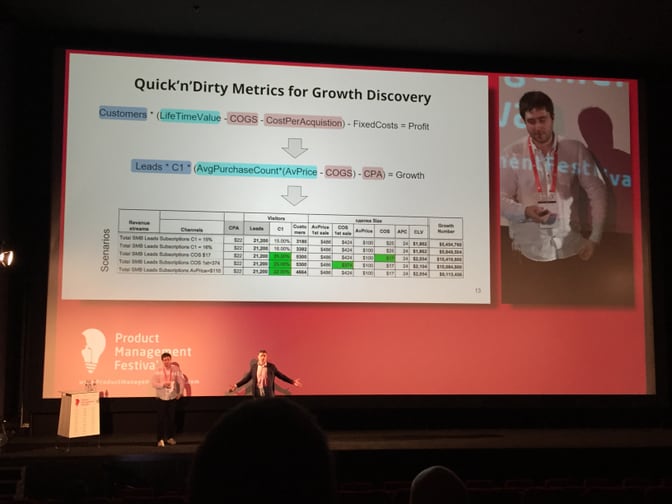
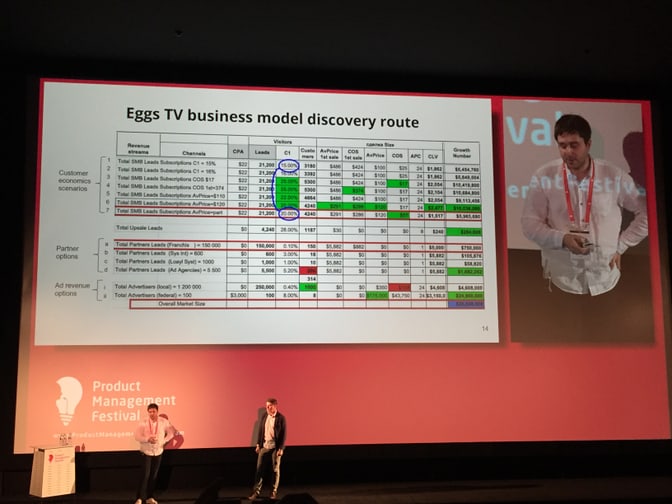

I also asked the two guys a question: "What cohort tool do you see mostly used by startups nowadays?"
They mentioned they used KISSMetrics in the past, but nowadays, Amplitude is THE thing recommended by their analytics team members.
A final important note: they always discussed about growth, not profit. While we often associate growth with money, growth can be about impact. Or about purpose as we practice it at Liip. When you start to see the talk and tools under this lens, you understand that they can be of help in many situation to avoid waste in what you craft.
Building accessible digital products for 100 millions users
By Saurabh Gupta, Program Manager at Microsoft
As with the speech by Minal from Google about the Next Billion Users, I feared to face a complacency talk. But Saurabh was clear from the start: he is driven by Microsoft's purpose "Empower every person", but he came here to talk about business, too.
He first quoted a consultancy firm: "Organizations who look at accessibility just as a compliance item miss out on business opportunities."
Backed by numbers, it indeed looks like a huge market opportunity:
- 1 billion people globally are differently abled
- 4.5% of the global population is color blind
- 3.3% of the global population suffer from visual blindness
- And 5% from earing loss
"Organizations who look at accessibility just as a compliance item miss out on business opportunities."
Other interesting facts on which industry put strong focus on accessibility:
- Education — for school and colleges
- Government — for citizen facing portal and tools
- Healthcare — for customer tools
- Enterprise — for equal employment opportunities
He continued explaining that accessibility is no rocket science. It just takes some time during the development process. There are plenty of certification's checklist on the web. We at Liip even open sourced a tool to check your accessibility compliance: A11ym.
But the basis of all certifications remain the same: any electronic and info tech must be accessible to people with disabilities. Punkt.
The main options to enable accessibility are:
- Use icons on top of colors only
- High contrast & dark them
- Screen reader ready
- Text size and display option
- Touch target size
- Closed captioning
As with UX or KPI setting in a digital project, accessibility should be a design parameter. Else, if done only at the end, it ends up being too costly.
All in all I agreed with what Saurabh spoke about during his speech. Moreover with his closing sentence: Accessible design is inclusive design.
To summarize the talk:
- Think accessibility at the design stage
- Designs are final only if they're adhering to accessibility standards
- Define an accessibility section for your PM specifications
- Call the feature complete only with accessibility supported
- Perform accessibility testing with at least one blind user
And if it helps you, think about accessibility in business terms. It's definitely a market advantage over your competitors.
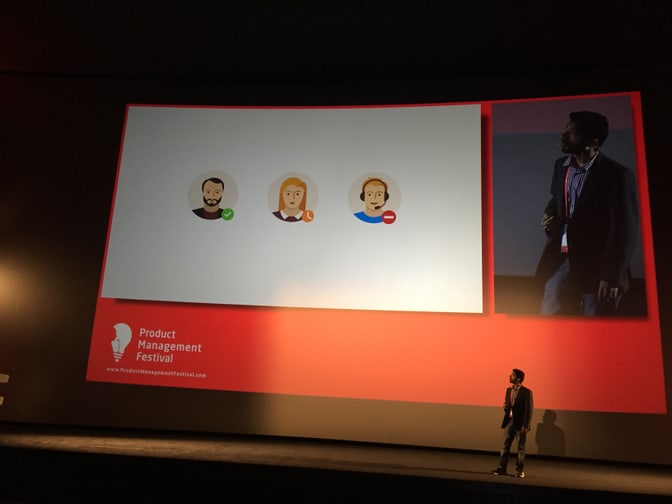
Becoming a problem solver
By Michael Perry, Director of Product and Marketing Technology at Shopify
We got to be careful about the product culture we've built. I often call this "solutionism". We must focus on problems first.
That's how Michael started the final keynote. 100% aligned from the beginning to the end!
I could relate to his chart about the addictive product creation loop (and I'm sure you do if you're an entrepreneur with 10k ideas per second):
- You have an idea
- You conceptualize the product, even in your head (the fun part)
- You launch the product
- You get your heroin dose, aka instant gratification, like buying the domain name, or kickstarting the project locally on your laptop
- You get your early learnings while trying to find the product-market fit
- You iterate, measure & enter hope phase
- "Why aren't people using this?" I know! Let's build new features
- Your mind starts to wander, you lose product interest
- You sunset the product
- You do a team/personal retrospective
- And then, you start the loop over again!
To avoid this addiction, you should ask yourself this simple question:
What problem am I solving?
And to see if you're on the right track, just check if customers pay you for your service. If not, then you're not fixing one of their problem.
I loved the analogy given by Michael when he was trying to build his "Kit" product (that was then acquired by Shopify). He said: "Small business owners would rather do their taxes than marketing on Facebook."
It took him several years to answer why small business were failing at doing marketing right:
- It seems it's because they try to do it all by themselves
- So why aren't they hiring new people?
- Because they have no time, no money, no trust, no way for doing so.
So Michael built the first VA employee. Via text SMS to Kit.
Once he focused on solving the problem so much, then he even forgot about the "idea" thingy.
One of his saying still resonate with me: "Product visionaries are a by-product of being problem solvers."
The key takeaways from his great story:
- Don't chase (technology) trends
- Don't chase vanity gratification in order to stay motivated
- Don't fake product success with vanity KPIs (don't care about # of downloads)
- Don't quit over failed product ideas, because you'd focus on the problem
- Obsess over the problem, not the solution. Do not care about the solution

Conclusion
These were my notes from the second day at the Product Management Festival 2018 edition.
My key learnings:
- Pricing is a feature of your product in itself. Tweaking it alone can make your client use your product even more (example of Coursera lowering its price if you finish your degree in advance)
- Innovation accounting is a simple spreasheet to track whether your fancy JIRA stories get an impact on key KPIs such as number of new clients or so
- Amplitude is the tool recommended for product analytics (i.e. cohort analysis) these days
- Accessibility is inclusive design. But business-wise, accessibility is also 1/7 of market share of the entire planet. I'd say that 5% of a product budget is necessary if you apply accessibility upfront. 10-20% if afterwards. For sure, accessibility is no more about compliance
- A good product manager focuses on problems. Relentlessly. Moreover, he doesn't care about the solution, except when it starts to fix a real problem
This conference is great. I can't help but to recommend it if you're a Product Manager or Product Owner. I'll definitely attend next year.

